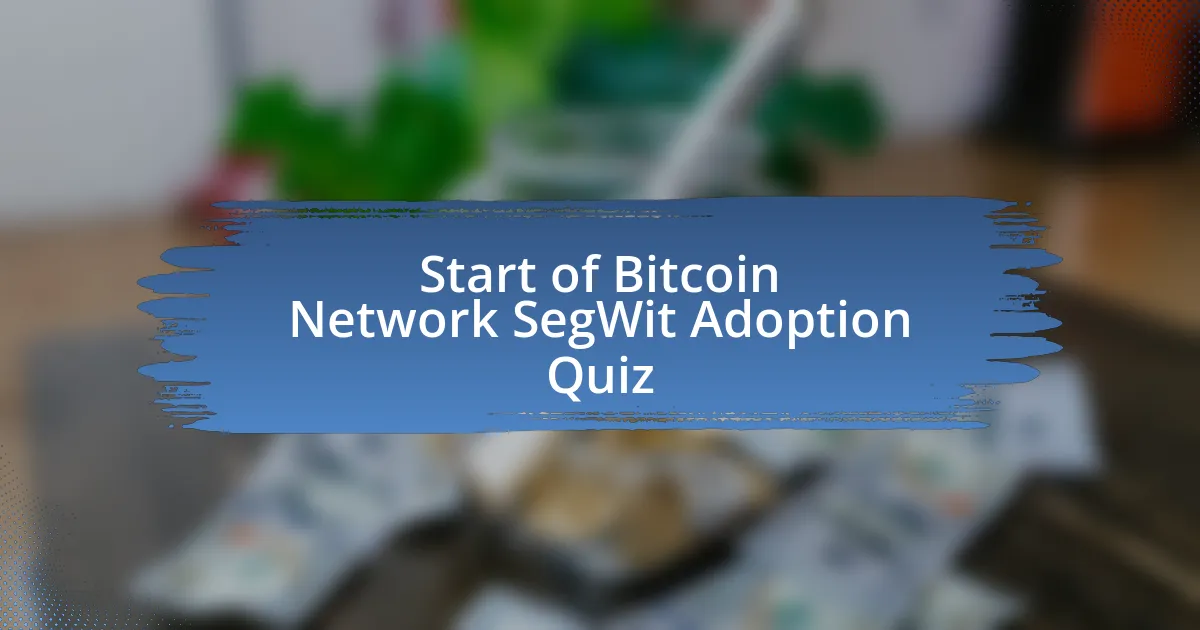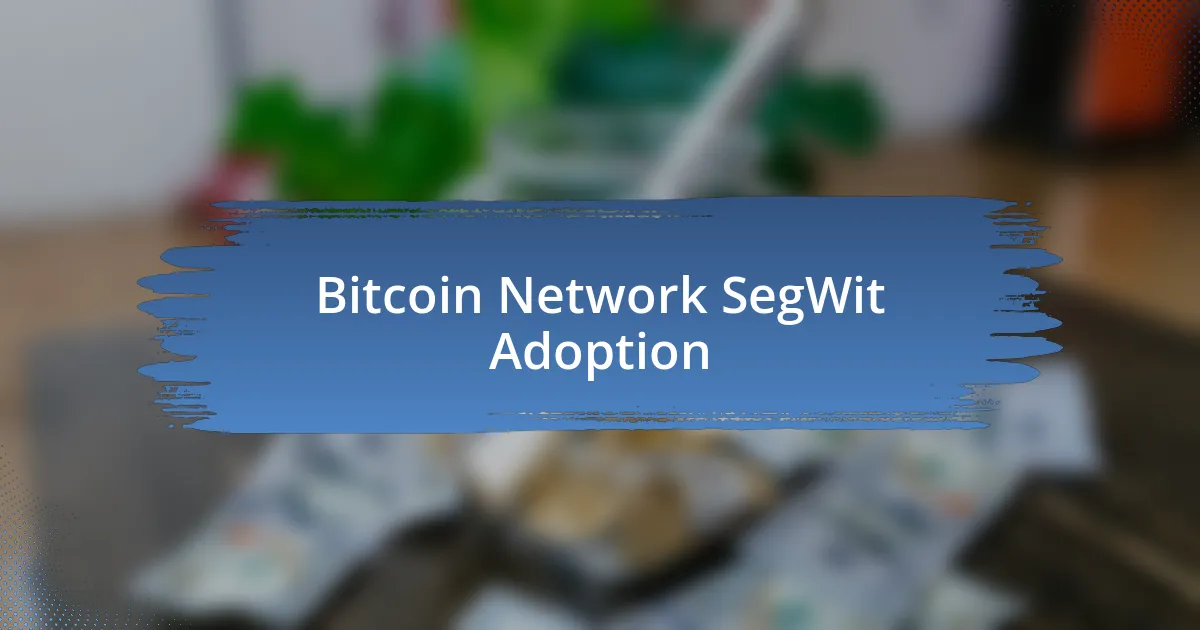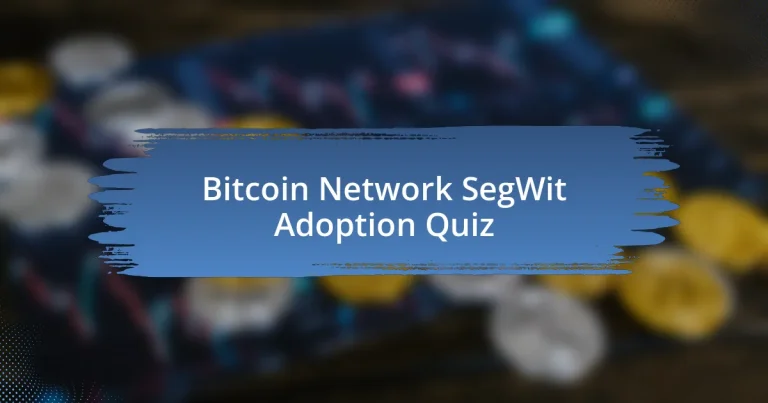
Start of Bitcoin Network SegWit Adoption Quiz
1. What is Segregated Witness (SegWit)?
- Segregated Witness is a new type of cryptocurrency wallet.
- Segregated Witness is a protocol upgrade enhancing Bitcoin`s transaction efficiency.
- Segregated Witness is an algorithm for mining Bitcoin.
- Segregated Witness is a method for exchanging Bitcoins securely.
2. When was SegWit activated on the Bitcoin network?
- August 24, 2017
- July 15, 2016
- December 5, 2017
- January 1, 2018
3. What problem did SegWit solve more than just the scaling issue?
- Transaction malleability
- Mining difficulty variations
- Centralized control issues
- High transaction costs
4. How does SegWit address Bitcoin`s scalability challenges?
- SegWit addresses scalability by changing the block size limit into a block weight limit, allowing for more transactions per block by segregating digital signatures.
- SegWit eliminates the need for miners, making transaction processing instantaneous and efficient.
- SegWit increases the block size limit to allow larger transactions to be processed at once.
- SegWit solves scalability by decreasing the number of transactions in each block, thus ensuring faster processing.
5. What changes did SegWit make to Bitcoin`s transaction structure?
- SegWit changed Bitcoin`s structure by increasing the overall block size and including more transaction data within each block.
- SegWit restructured Bitcoin`s transactions by creating a new currency that operates alongside Bitcoin, enhancing speed and capacity.
- SegWit altered Bitcoin`s transaction structure by introducing a new concept called `witness` where signature data is separated from transaction data, reducing the size of each transaction and increasing block capacity.
- SegWit modified Bitcoin`s transaction structure by eliminating all signature data to make transactions faster.
6. What is the role of SegWit in Bitcoin transaction security?
- SegWit verifies all participants` identities in transactions.
- SegWit creates additional backup copies of each transaction.
- SegWit enhances transaction security by preventing signature alterations post-transaction.
- SegWit removes all unnecessary transaction data.
7. What is the significance of SegWit`s activation in Bitcoin history?
- The activation of SegWit resulted in the immediate doubling of Bitcoin`s block size, enabling faster transactions.
- The activation of SegWit marked a significant moment in cryptocurrency history, catalyzing a nearly 50% increase in Bitcoin`s price in just a week.
- The activation of SegWit led to a complete overhaul of Bitcoin`s consensus algorithm, changing it to proof-of-stake.
- The activation of SegWit eliminated all transaction fees on the Bitcoin network, making transactions completely free.
8. How did the adoption of SegWit impact Bitcoin transaction fees?
- The adoption of SegWit had no impact on transaction fees, keeping them the same as before.
- The adoption of SegWit eliminated transaction fees completely, allowing free transactions on the network.
- The adoption of SegWit reduced transaction fees by increasing block capacity and optimizing transaction data, allowing more transactions to be included in each block.
- The adoption of SegWit increased transaction fees by limiting block capacity and reducing transaction data.
9. Which exchanges were among the first to adopt SegWit?
- Kraken
- Bitfinex
- Gemini
- Bittrex
10. What is the Lightning Network, and how is it connected to SegWit?
- The Lightning Network is a separate cryptocurrency based on a different blockchain protocol, independent of SegWit technology.
- The Lightning Network is a decentralized exchange that operates solely on the SegWit capabilities to enhance security.
- The Lightning Network is a parallel chain related to the Bitcoin blockchain, developed after the SegWit introduction, enabling automated payments between users without adding transactions to the main blockchain.
- The Lightning Network is a protocol for direct trading between cryptocurrency exchanges that requires SegWit transactions to execute.
11. Are people, wallets, and other services forced to use SegWit?
- Yes, all must use SegWit.
- Only wallets are forced to use SegWit.
- People are required to use SegWit.
- No, they are not forced to use SegWit.
12. What is the current adoption rate of SegWit as of September 2021?
- 60.15%
- 50.67%
- 70.38%
- 85.42%
13. What were the proposed alternatives to SegWit?
- Increase block size limit to 2MB
- Replacing Bitcoin with a new token
- Halving block rewards
- Implementing a new blockchain
14. How does SegWit reduce the size of blocks?
- SegWit compresses the entire block into a smaller file size.
- SegWit reduces block size by separating signature data from transactions.
- SegWit increases the size of blocks by embedding more data.
- SegWit eliminates the need for blocks entirely.
15. What is the significance of the block weight cap introduced by SegWit?
- The block weight cap eliminates transaction fees altogether.
- The block weight cap limits the total size of the blockchain.
- The block weight cap resets the blockchain every month.
- The block weight cap allows for more transactions per block.
16. What is the impact of SegWit on the Bitcoin network`s overall security?
- SegWit improves the overall security of the Bitcoin network by preventing transaction malleability.
- SegWit reduces security by increasing transaction processing time.
- SegWit has no effect on the overall security of the Bitcoin network.
- SegWit decreases the security of the Bitcoin network by enabling easier hacks.
17. How does the adoption of SegWit by exchanges contribute to the network?
- It reduces transaction fees and boosts scalability.
- It makes transactions slower and more expensive.
- It has no impact on transaction speeds or costs.
- It only affects mining rewards negatively.
18. What is the role of wallet providers in the adoption of SegWit?
- Wallet providers hinder the implementation of SegWit by ignoring user needs.
- Wallet providers restrict the use of SegWit to certain transactions only.
- Wallet providers facilitate SegWit adoption by enabling compatibility and user access to the feature.
- Wallet providers have no influence on the adoption of SegWit in the Bitcoin network.
19. How has the adoption rate of SegWit evolved over time?
- The adoption rate of SegWit remained constant at 7% until 2020.
- The adoption rate of SegWit surged to 90% in just three months after its activation.
- The adoption rate of SegWit grew from 7% in October 2017 to over 30% by February 2018.
- The adoption rate of SegWit decreased from 50% in 2017 to 40% in 2018.
20. What is the significance of the SegWit2x proposal?
- The SegWit2x proposal introduced smart contracts to Bitcoin.
- The SegWit2x proposal was intended to eliminate the Bitcoin block size limit entirely.
- The SegWit2x proposal focused on improving transaction fees solely.
- The SegWit2x proposal aimed to increase network capacity by implementing a 2 MB block size limit.
21. How does SegWit support the development of second-layer solutions?
- SegWit increases the block size limit, allowing for larger transaction sizes on the Bitcoin network.
- SegWit mandates all transactions to use second-layer solutions for faster processing.
- SegWit paves the way for future improvements on the Bitcoin network, including the deployment of second-layer solutions like the Lightning Network.
- SegWit eliminates the need for transaction fees entirely, making transactions free.
22. What are the challenges facing SegWit adoption?
- Technical difficulties and resistance from the community
- Increased block size to 2MB
- Mandatory implementation by all wallets
- Higher transaction fees for all users
23. What is the impact of SegWit on transaction validation times?
- SegWit decreases the number of transactions that can be processed in a block.
- SegWit has no impact on transaction validation times.
- SegWit slows down transaction validation times due to increased block size.
- SegWit accelerates transaction validation times by maximizing data capacity per block and streamlining transactional throughput significantly.
24. How does SegWit reduce transaction malleability?
- By separating signature data from transaction data
- By combining multiple transactions into one
- By increasing the block size limit
- By encrypting transaction IDs
25. What is the current status of SegWit adoption by major exchanges?
- SegWit has been abandoned by all exchanges.
- SegWit is only adopted by small, unknown exchanges.
- As of 2022, only 6 out of 18 exchanges have fully adopted SegWit.
- SegWit is fully adopted by all major exchanges.
26. What is the primary reason for introducing SegWit?
- To eliminate all transaction fees entirely.
- To allow unlimited block size without restrictions.
- To ensure blockchain anonymity for all users.
- To increase scalability of the Bitcoin blockchain.
27. How does SegWit optimize transaction data?
- SegWit optimizes transaction data by making transactions entirely anonymous.
- SegWit optimizes transaction data by increasing the size of each transaction.
- SegWit optimizes transaction data by separating signature information from transaction data.
- SegWit optimizes transaction data by merging all data into one block.
28. What is the significance of the block weight limit introduced by SegWit?
- The block weight limit allows for more transactions per block by considering the segregation of digital signatures.
- The block weight limit limits the number of blocks that can be created per hour.
- The block weight limit decreases transaction fees by making transactions larger.
- The block weight limit has no impact on the number of transactions in a block.
29. How does SegWit support the development of smart contracts on the Bitcoin network?
- SegWit`s implementation has paved the way for further innovation within the realm of cryptocurrency, including the development of smart contracts.
- SegWit simply makes Bitcoin transactions faster without any impact on smart contracts.
- SegWit restricts the use of smart contracts on the Bitcoin network entirely.
- SegWit increases Bitcoin`s energy consumption, hindering the development of smart contracts.
30. What is the impact of SegWit on the overall appeal and performance of the Bitcoin network?
- The adoption of SegWit has improved the overall appeal and performance of the Bitcoin network by reducing transaction fees and increasing scalability, making it more efficient and secure.
- The introduction of SegWit led to higher transaction fees and congestion on the Bitcoin network.
- SegWit decreased the maximum block size limit, making transactions slower and less efficient.
- SegWit`s implementation has had no effect on Bitcoin`s performance or appeal among users.

Congratulations! You’ve Successfully Completed the Quiz
Completing the quiz on Bitcoin Network SegWit adoption marks a significant step in your understanding of an important aspect of cryptocurrency technology. Throughout the quiz, you explored key concepts such as the benefits of SegWit and its role in improving Bitcoin’s scalability. Each question was designed to enhance your knowledge and challenge your perspectives on how this innovation impacts transaction processing times and fees.
As you answered the questions, you likely gained insights into how SegWit helps reduce the size of transactions and allows for more efficient block space usage. This understanding is crucial as the Bitcoin network continues to evolve. Additionally, you may have learned about the ongoing debates in the crypto community regarding technical upgrades and user adoption, highlighting the dynamic nature of this field.
We invite you to dive deeper into the topic of Bitcoin Network SegWit adoption. Check out the next section on this page, where you’ll find comprehensive information that will expand your knowledge. Whether you are a newcomer or a seasoned enthusiast, there’s always more to learn about the intricacies of Bitcoin and its advancements. Happy exploring!

Bitcoin Network SegWit Adoption
Understanding Bitcoin Network SegWit
Segregated Witness (SegWit) is a significant upgrade to the Bitcoin protocol, aimed at improving transaction efficiency and capacity. It separates the transaction signature data from the main transaction, allowing more transactions to fit into each blockchain block. This change addresses two critical issues in Bitcoin: scalability and transaction malleability. By reducing the size of each transaction, SegWit enhances the overall transaction throughput of the Bitcoin network.
Importance of SegWit Adoption
Adopting SegWit is crucial for Bitcoin’s scalability and long-term functionality. It allows for more transactions per second, mitigating network congestion during peak usage times. Additionally, SegWit enhances the user experience by decreasing confirmation times and lowering transaction fees. Widespread adoption fosters a more robust ecosystem, inviting further innovations on the Bitcoin network.
Current State of SegWit Adoption
The current state of SegWit adoption reflects a gradual increase in its use within the Bitcoin network. As of the latest data, approximately 50-60% of Bitcoin transactions utilize SegWit. The adoption rate varies among wallets and exchanges, with some major services like Binance and Coinbase supporting SegWit transactions. This growth indicates a healthy trend toward improved network efficiency.
Challenges in SegWit Adoption
Despite its benefits, challenges exist in SegWit adoption. One primary issue is user awareness and education. Many users and wallet providers are still unfamiliar with SegWit benefits. Moreover, backward compatibility concerns can deter some older software from supporting SegWit transactions. These challenges can slow down the overall adoption rate, limiting the upgrade’s effectiveness.
Future Implications of SegWit on Bitcoin’s Ecosystem
SegWit’s future implications for Bitcoin’s ecosystem are significant. Enhanced transaction speed and reduced fees encourage broader adoption and use. Moreover, its implementation can lead to more complex smart contracts and second-layer solutions like the Lightning Network thriving. Ultimately, increased SegWit adoption is anticipated to strengthen Bitcoin’s position as a leading cryptocurrency by improving user experiences and network functionality.
What is Bitcoin Network SegWit Adoption?
Bitcoin Network SegWit adoption refers to the implementation of the Segregated Witness (SegWit) protocol upgrade within the Bitcoin network. SegWit enhances transaction efficiency and increases block capacity by separating signature data from transaction data. As of October 2023, SegWit adoption has reached approximately 70% of all Bitcoin transactions, demonstrating significant integration among wallets and exchanges.
How does SegWit improve the Bitcoin network?
SegWit improves the Bitcoin network by increasing the block size limit and allowing more transactions to fit within a block. It reduces transaction fees by decreasing the size of individual transactions on the Bitcoin blockchain. Furthermore, it mitigates issues related to transaction malleability, enhancing the overall security and reliability of transactions.
Where can you check the SegWit adoption rate?
You can check the SegWit adoption rate on various blockchain analytics websites, such as Blockchair and BitcoinVisuals. These platforms provide real-time statistics and visualizations of SegWit usage on the Bitcoin network, including the percentage of transactions utilizing SegWit.
When was SegWit activated on the Bitcoin network?
SegWit was activated on the Bitcoin network on August 24, 2017, after reaching the required signaling threshold in the BIP9 deployment process. This activation marked a significant milestone in enhancing the protocol’s scalability and efficiency.
Who initiated the development of SegWit?
The development of SegWit was initiated by Bitcoin developer Pieter Wuille, along with contributions from other key developers in the community. The proposal, known as BIP141, aimed to address various challenges facing the Bitcoin network, particularly scalability and transaction malleability.


